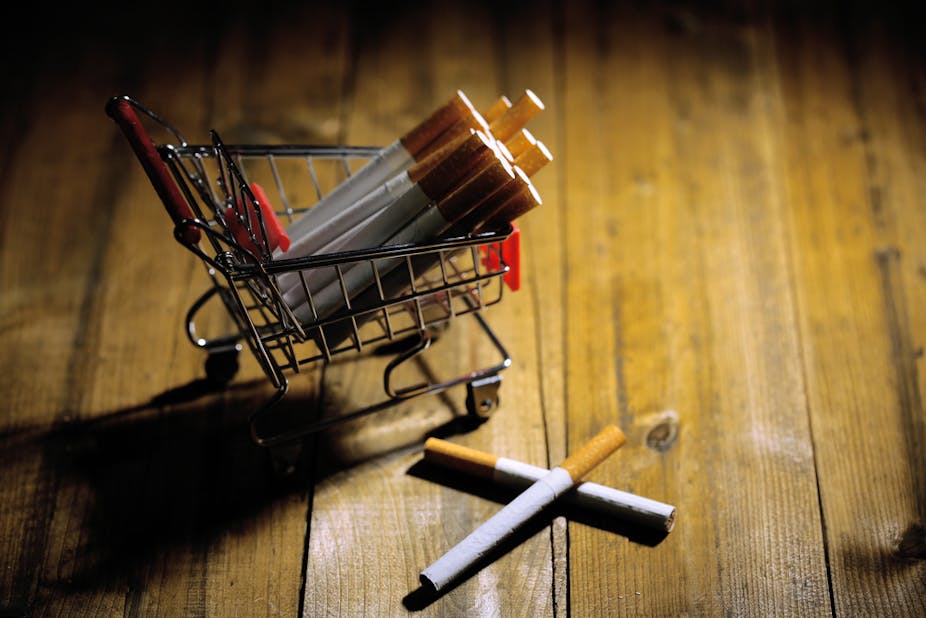Australia has been hugely successful in reducing the number of people who smoke. Today, 12.8% of people over age 14 smoke on a daily basis, which is nearly half the daily smoking rate in 1991 (24.3%).
This reduction in smoking has been largely achieved by curbing the consumer demand for tobacco products. Tax increases, tobacco advertising bans, smoke-free public places, graphic health warnings on cigarette packs and emotive anti-smoking mass media campaigns have diminished the appeal of smoking and contributed to lowering smoking rates.
While these tobacco demand-reduction strategies have been widely implemented in Australia and internationally, comparatively little has been done to control the sale and supply of tobacco products. This needs to change.
Unfettered supply
Tobacco is sold in nearly every shop, on every street corner, in every neighbourhood. You can buy however much you want, whenever you like, from practically anyone.
The tobacco industry can make and sell as much product as it wants and generate profits with little regard to the accumulating public health toll.
New tobacco products can enter the market at any time with near zero restrictions on what ingredients can be added. There are no requirements for the industry to disclose how products are made or developed.
In practical terms, this means the tobacco industry can freely create products that are increasingly addictive, include ingredients that mask the harshness of tobacco smoke, and then sell them unreservedly on the market as if there were simply another consumer good.

Tobacco companies are required to maximise share prices and profits for stakeholders and must subsequently challenge any regulation or policy that threatens those profits.
Several different models have been proposed to better regulate the sale and supply of tobacco, with the eventual goal being to end the sale of tobacco products.
Not-for-profit suppliers
One possible regulatory model is to transform the tobacco market from one controlled by for-profit corporations that have a mandate to sell more cigarettes, to one managed by a not-for-profit enterprise that has a mandate to promote public health.
This transformation could be achieved by purchasing existing tobacco companies at fair market value.
The goal of the newly formed pro-health tobacco supply monopoly then becomes to support, not stand in the way of, effective demand-reduction strategies. Tobacco products would also then be developed and sold in ways that facilitate quitting and discourage uptake.
Two barriers to this approach include the significant funds required to purchase these highly profitable companies and the complex legal issues due to the transnational operations of the companies.
Price caps
Others have suggested introducing price cap regulation on tobacco products that would set a maximum price that cigarette companies could charge for their products.
In high-income countries such as Australia that also have high tobacco taxes, tobacco companies have been enabled to increase prices alongside tax increases and thus maintain their profits in the face of shrinking sales.

Capping cigarette manufacturers’ prices but not the price that consumers pay at retail, would still allow tax increases to remain a key tobacco control policy.
This approach would reign in the excess tobacco manufacturer profits that serve as a motivation to usurp effective tobacco control.
Sinking lid
New Zealand researchers have proposed a “sinking lid” approach to eliminating the commercial sale of tobacco products.
Legislation would introduce regular reductions in the allowable amount of tobacco released to consumers, with the goal of achieving zero commercial sales within a fixed period. A period of ten years has been proposed, with a reduction of 5% of the initial level allowed on the market every six months.
The sinking lid could result in increased efforts by manufacturers and retailers to maintain or increase demand, in order to maintain profits. But this could be combated by maintaining and increasing the traditional tobacco demand-reduction strategies.
Limiting retail licences
“Place” is a key part of the tobacco marketing mix. There is a greater concentration of tobacco outlets in lower socioeconomic communities, even after adjusting for increased smoking rates.
The density of retailers and proximity of retailers to schools appear to increase smoking behaviour and tobacco purchasing by youth.
Venues such as bars, pubs and clubs and convenience stores are favoured much more by lighter smokers, suggesting these types of outlets may contribute to impulse purchasing.
But very little has been done to address and reform where and by whom tobacco products may be sold in Australia.
Nor is there a consistent approach to tobacco licensing across Australia. Most tobacco licensing schemes do little more than require sellers to pay a small fee in order to be able to sell.
The convenient supply of tobacco could then also be reduced by restricting the number and type of tobacco outlets through a system of limiting tobacco licences.
Unlike tobacco, Australia has a long history of controlling the supply of other potentially harmful, but legal products, such as alcohol, food, and prescription medications. While we’ve had great success reducing tobacco use through a demand-reduction approach, accelerating this decline and ending the tobacco epidemic will require creative and innovative policy approaches that involve changing the supply of tobacco.
Editor’s note: Comments will close at 5pm AEST today and will reopen on Monday morning.

